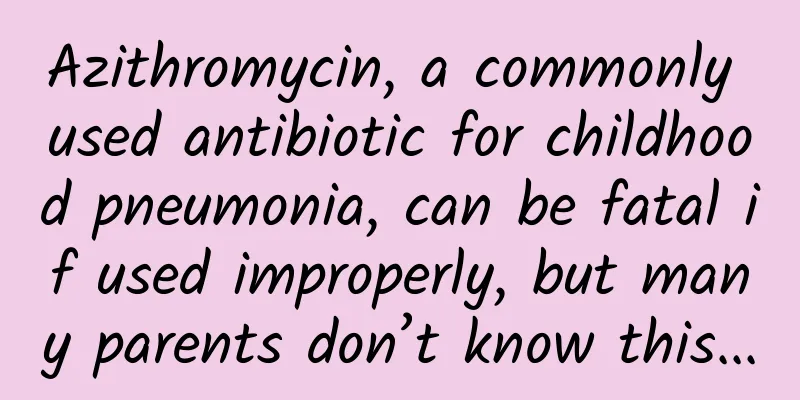Azithromycin, a commonly used antibiotic for childhood pneumonia, can be fatal if used improperly, but many parents don’t know this...

|
Since the beginning of winter, many places have experienced a "cliff-like" drop in temperature, various common winter diseases have quietly increased, and pediatric pneumonia has also entered its peak season. The little patients in the pediatric department of the hospital have red faces and keep coughing, which really makes their parents feel distressed. Mycoplasma pneumoniae and Chlamydia pneumoniae are common pathogens that cause pneumonia in children, and one of the "nemesis" of these two pathogens is azithromycin. Azithromycin is a commonly used "weapon" for pediatricians to fight infection, but its use is very particular. If used incorrectly, it will not only fail to achieve the effect of treating the disease, but may even be fatal. Dosage form and dosage are optional Dosage form recommendation: When used to treat children's diseases, granules and dry suspensions are preferred, which should be dissolved in warm water before taking; tablets and capsules are not recommended for preschool children. Dosage determination: For patients with a body weight of less than 45 kg, the dose is determined according to the body weight; for patients with a body weight of more than 45 kg, the dose can be used as an adult. Parents should pay attention to the dosage form when using the medicine, and the total dose during the course of treatment should not exceed 1500 mg. Time selection: Most domestic dosage forms require taking the drug 1 hour before or 2 hours after a meal; while imported dosage forms can be taken with food. Inappropriate for concurrent use: Do not take with antacids containing aluminum and magnesium. Taking it is a "technical job" Many parents have heard doctors remind them: "Take azithromycin for 3 days and then stop for 4 days." Some parents worry whether this course of medication is enough. In fact, this is because azithromycin has a long half-life and can maintain effective antibacterial activity for a long time (4 days after discontinuation of the drug). At present, in addition to the three-day medication method of "take three days and stop four", there is also a five-day medication method, that is, take dose A on the first day, and take dose A/2 orally every day from the second to the fifth day (dose A is determined by body weight). If the condition is not effectively controlled after taking the medicine according to the course of treatment, you must consult a doctor in time and adjust the treatment plan under the doctor's guidance. Be careful when taking medicine Macrolide drugs such as azithromycin can cause prolongation of the QT interval of the heart rhythm during use. Therefore, patients with heart disease cannot use azithromycin, otherwise there is a risk of fatal arrhythmia. The following 4 types of children should avoid using it: 1) Patients with confirmed QT interval prolongation and bradycardia; 2) Patients with a history of torsades de pointes; 3) Those who are in arrhythmogenic conditions, such as uncorrected hypokalemia and hypomagnesemia; 4) Those who are currently using antiarrhythmic drugs, antipsychotic drugs or antidepressants. Such "mixing" can easily be fatal In addition, when using azithromycin, you should be careful not to "mix" other drugs at will. For example, azithromycin combined with digoxin can cause cardiotoxicity; combined with statins, it can cause acute liver necrosis; combined with compound licorice tablets, it can cause arrhythmia; combined with ergotamine, it can cause ergotamine poisoning... These "mixes" may cause fatal harm. Therefore, before giving your baby azithromycin, please inform your doctor in advance of other medications your baby is taking to avoid "mixing" and causing serious adverse reactions. Winter is the peak season for diseases. Parents should pay attention to the following points: 1. If your baby has a fever, you should seek medical attention promptly, get a clear diagnosis, and receive symptomatic treatment. Do not blindly use medication to delay the condition. 2. Be sure to inform your doctor of your basic medical history before taking any medication, and use the medication under the doctor's guidance. 3. Follow the doctor's advice and take the medicine according to the recommended dose and course of treatment. Do not increase the dose at will to avoid drug accumulation. 4. Pay attention to allergic reactions (such as rash, itching, etc.) during medication. If any occur, stop taking the medicine immediately and seek medical treatment. 5. Take good care of your baby’s own protection, enhance immunity, and get vaccinated in time. Author: Zhang Wei, Chief Pharmacist of Shanxi Yangmei Group General Hospital Review expert: Ren Jianye, chief pharmacist of Shanxi Yangmei Group General Hospital Wei Guoyi, Chief Pharmacist, Beijing Anzhen Hospital, Capital Medical University |
>>: What kind of tea is Guangxi Liubao tea? What does Liubao tea taste like?
Recommend
Menstrual blood that smells bad
By observing menstrual blood, you can effectively...
Can I drink water before taking the glucose tolerance test?
A woman's body will undergo many changes duri...
What causes women's back pain?
Low back pain is a common condition for many peop...
How to maintain after hysterectomy?
The uterus plays a role in the female body that c...
Early symptoms of pituitary tumors in women
Nowadays, the frequency of pituitary tumors is ge...
Understand what is ICL lens implantation? Who can undergo ICL lens implantation?
References: Chen Li. ICL artificial lens implanta...
What medicine is good for excessive leucorrhea?
Leucorrhea is a barometer of women's health, ...
How much does the ligation surgery cost?
Religation surgery means that a person has underg...
What to do if your period doesn't bleed?
If there is no bleeding during menstruation, or t...
What's wrong with the blood stains on my underwear?
There's nothing more confusing than finding b...
Misconceptions about the use of sanitary napkins: have you fallen into this trap?
Content from : Gu Zhuowei Shanghai Renji Hospital...
Do women have headaches during menopause?
Once female friends enter menopause, they will ex...
What if there is no echo at 45 days of pregnancy?
Women are very sensitive during pregnancy and pay...
What are some yoga exercises for breast enhancement before bed?
Now more and more people choose to enlarge their ...
Adrenal hyperplasia in women
The adrenal cortex is the external tissue located...









